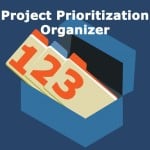We’ve been talking this week about how to get past barely managed chaos using a project portfolio management process.
I won’t lie. It’s a lot of work to make this happen.
You, personally, need to be motivated to make this year different than than the last. And your organizational leaders also need to understand what’s in it for them.
(And we’re here to help you do that with the Project Prioritization Organizer.)
But back to your motivation. Let’s look at some of the positive outcomes that happen when you are managing all of your delivery team’s work on a single list, both for you and your organization.
#1 – The top projects get done
While it might feel like a lot of work isn’t getting done (after all, a ranked list means some things fall to the bottom), the projects toward the top of the list start to experience more momentum than they ever have before.
Everyone’s attention is on them. Roadblocks are worked around. Hold-ups are batted down.
And then all of a sudden they are done. Then it’s on to the next item on the list, please!
#2 – Executives hold each other accountable
When your Steering Committee meets every other week to review the active and pending projects, executives will start to hold each other accountable. Is this project being held up because you can’t get stakeholders to come to your meetings? All of a sudden that issue gets a lot of visibility. It’s not just holding up this project, but holding up the projects under it on the list.
#3 – Business cases come under scrutiny
You’ll also start to see executives hold each other accountable to the business rationales behind each of the projects. Because they are all negotiating over a shared pool of resources, they will start to call out each other’s false projections.
This might not happen the first time around, but when the next project pops up with the same expected benefit, you better believe someone is going to notice and say something.
#4 – You are less of the bad guy
All of this amounts to the business analyst and project manager being less of a bad guy. It’s not about you saying “no”; it’s about this versus that.
It’s a powerful position to be in, because you get to offer up choices and options and enable your executive team to buy in to what they choose to do with the resources they have.
#5 – Developers get more committed
But the changes do not just happen at the executive level. In the old world, your development team gets involved after a project is prioritized, scrutinized, and an arbitrary delivery date is set.
The full implementation of a portfolio management process requires you get delivery team input early. Once the project is active, they’ve already had a say. And as a result, they are more invested in following through.
#6 – More good ideas surface
In an organization that has little track record of delivering results, good ideas never see the light of day. No one expects anything to happen from them anyway, so why bother bringing them up.
Once you start finishing projects and delivering value, people notice. This can result in a flood of new project proposals, which is a great way to surface game-changing ideas.
#7 – Elevated business analyst role
But something needs to be done with all those new ideas. We know they can’t go straight to the development team. What’s more, there is likely to be redundancy and overlap among the ideas.
In comes the business analyst, who gets to work at more of an enterprise level, vetting new ideas and ensuring they are fleshed out enough to get a solid development estimate. This is a great place to be as a BA.
#8 – Requirements meetings get a little easier
Once people see projects getting delivered, your message of “that’s out of scope, but let’s put it on the parking lot” becomes a lot more effective. As a result, you start to see your requirements meetings for active projects being a little easier to manage in terms of staying on scope.
The parking lot isn’t a deep, dark place where ideas never see the light of day. An item on the parking lot can become a project request which can get prioritized on the project list.
>>Get the Project Prioritization Organizer

Click here to learn more about the Project Prioritization Organizer
